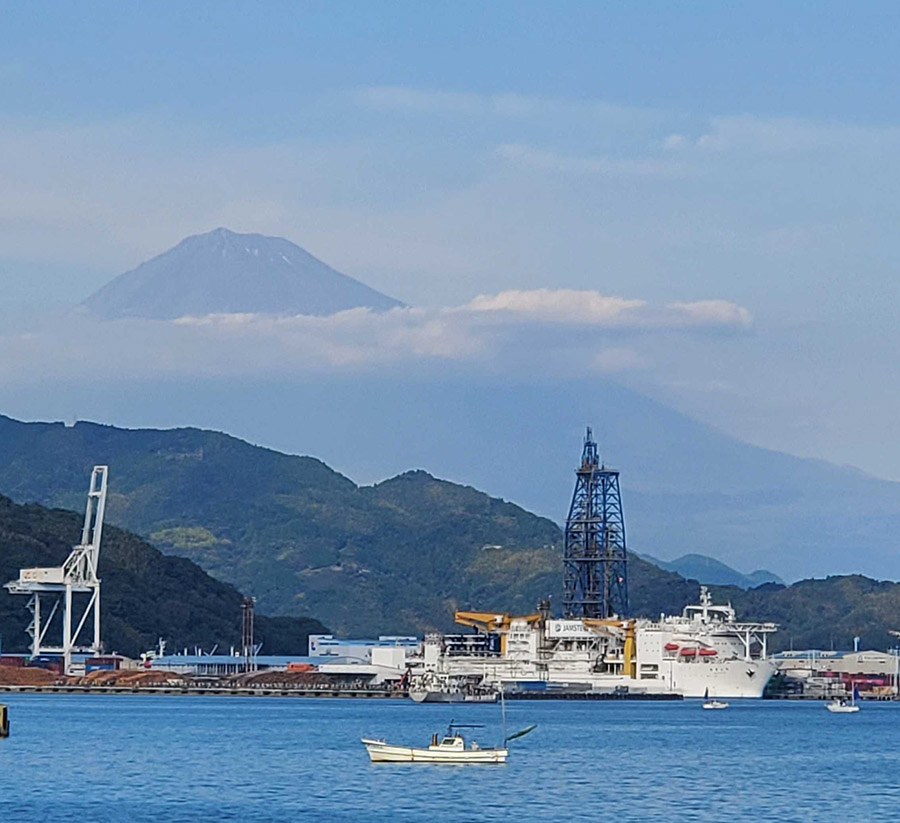
4 minute read
Predicting the Unpredictable
Geoscience Professor Studies Earthquake Sediment in Japan
In 2011 a massive tsunami ravaged Japan, leaving 18,500 people dead or missing in its wake and more than a million buildings destroyed or damaged, including nuclear power facilities. Waves nearly 20 feet high were triggered by a 9.0 magnitude earthquake in the ocean about 250 miles northeast of Tokyo in the Japan Trench, part of the Pacific Ring of Fire.
A decade after the tragedy, a Japanese research vessel called the R/V Kaimei sent a device down, down, down in that Ring of Fire — about 5 miles down, deeper than anyone had ever drilled below sea level — to core sediment samples for scientific analysis.
Enter Sally Zellers, a biostratigrapher and professor of Geoscience at the University of Central Missouri, and a crew of about 30 scientists assembled from around the globe to study these samples through the International Ocean Discovery Program. Zellers was not the only one traveling from Warrensburg, Missouri; with her was bobblehead Mo the Mule, who became an honorary crew member and official blogger for Expedition 386.

Learning Through Immersion
Students in UCM’s Our Digital Earth course bid their professor and their mascot farewell in November 2022. They had researched the 2011 tragedy and used ArcGIS StoryMaps software to explore the geography of the region. Next they would follow Zellers’ blog as she posted from the onshore sample party (OSP) aboard the Chikyu drilling vessel, docked in Japan’s Port of Shimizu.
“The objectives were to document the occurrence interval and establish the recurrence probability of very large earthquakes and tsunamis throughout Japan,” says Zellers, who has participated in research expeditions off the shores of Washington and Oregon and in the Gulf of Alaska, Gulf of Mexico and Antarctica.
Her expertise is micropaleontology, studying tiny fossils of single-cell marine organisms called foraminifera to help determine the age of the sediment and provide insights into past ocean conditions. There have been about 50,000 species of foraminifera over time, and they make their shells out of different things. Like clams, one of those things is calcium carbonate, and below about 2.5 miles in the ocean, calcium carbonate dissolves. This means that Zellers should not be finding the organisms in the core samples taken 5 miles down — unless the fossils were buried rapidly by earthquake-induced currents. The fossils Zellers finds and how they’re preserved can help determine where the earthquakes originated.
Zellers and the international crew of scientists aboard the Chikyu worked 12-hour shifts studying samples taken from the 20-foot sediment cores that the Kaimei obtained from the ocean floor of the Japan Trench. Zellers used a paintbrush to separate mud from sand and isolate specimens smaller than a grain of sand.
The crew of sedimentologists, geochemists, geophysicists, microbiologists and micropaleontologists like Zellers had more than 18,000 total samples to take and involved Mo the Mule in every step of the process.

“One time while sampling, Mo fell into the sampling bin and almost became a sample,” wrote Melzora Mills, a Nursing major who took Zellers’ Our Digital Earth course in fall 2022. “He is happy that it was a successful trip. He also hopes the samples that they collected will be able to help scientists and other authorities predict another earthquake and tsunami long before it occurs so that they can prevent as much loss of life as possible.”
Zellers continues to analyze samples sent to Warrensburg from the expedition. In January she obtained a Post Expedition Activity Award from the United States Science Support Program to hire a research assistant, involving more students in an expedition that could help predict the unpredictable.









